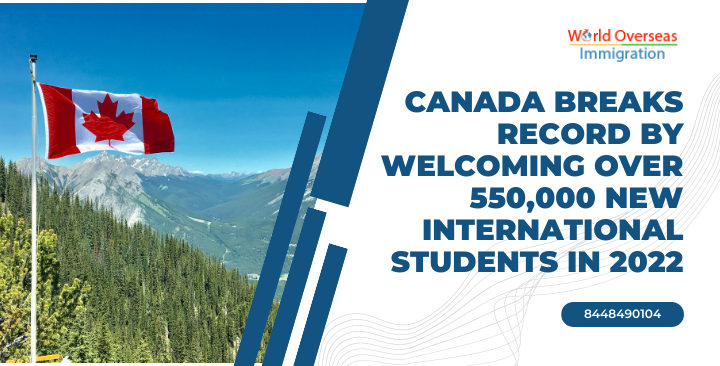New data from Immigration, Refugees and Citizenship Canada (IRCC) shows Canada will welcome a record 551,405 international students in 2022 from 184 countries.
Furthermore, as of December 31, 2022, 807,750 international students hold valid study permits, the largest number ever.
The number of study permits issued has increased significantly in recent years.
In 2021, a total of 444,260 new study permits take effect, an increase from 400,600 in 2019 (2020 saw a decrease due to the COVID-19 pandemic). This means that 107,145 more study permits take effect in 2022 than in 2021.
As a result, there has been a significant increase in the number of students in Canada as well. In 2019, there were 637,860 international students in Canada. This number decreased in 2020, due to the pressure of the pandemic – with a total of 617,315 international students returning to the country in 2021. With a relative return to normal last year, Canada now has approximately 170,000 more international students at the end of 2022 than in 2019.
The top 10 source countries for new international students entering Canada in 2022 were:
- India (226,450 students);
- China (52,165 students);
- Philippines (23,380 students);
- France (16,725 students)
- Nigeria (16,195 students);
- Iran (13,525 students);
- Republic of Korea (11,535 students);
- Japan (10,955 students);
- Mexico (10,405 students); And
- Brazil (10,405 students).
Additionally, the top 10 source countries for international students already living and studying in Canada as of December 31, 2022 were:
- India (319,130 students);
- People’s Republic of China (100,075 students);
- Philippines (32,455 students);
- France (27,135 students);
- Nigeria (21,660 students);
- Iran (21,115 students);
- Republic of Korea (16,505 students);
- Vietnam (16,140 students);
- Mexico (14,930 students); And this
- United States (14,485 students).
International students within Canada in 2022 attend designated educational institutions in the following provinces:
- Ontario (411,000 students);
- British Columbia (164,000 students);
- Quebec (93,000 students);
- Alberta (43,000 students);
- Manitoba (22,000 students);
- Nova Scotia (20,850 students);
- Saskatchewan (13,135 students);
- New Brunswick (11,140 students);
- Newfoundland and Labrador (6,175 students); And
- Prince Edward Island (4,485 students).
Why is Canada so popular among international students?
There are many reasons why Canada remains a top destination for international students – including quality of education, low cost, finding work and opportunities to immigrate after post-graduation.
In fact, a recent report by IDP—an international education agency that specializes in student placements around the world—showed that Canada was the preferred destination for international students globally.
quality of education
Contributing to this strong position is the excellent quality of education that can be had in Canada. Many Canadian institutions rank among the most prestigious schools internationally (especially when considering specific programs and faculties). Therefore Canadian schools are globally recognized, which is a major feature in attracting international students.
Cost
The Canadian dollar’s more favorable exchange rate allows better conversion with international currency than its counterparts. This means that international students can obtain post-secondary education at a lower cost than many other countries with comparable levels of education, such as the US or the UK. The average cost of graduate education in Canada (depending on the province, institution, and program of study) is between $20,000 and $40,000 CAD. Additionally, Canada offers several financial aid programs for international students, further alleviating financial stress.
work opportunities
The ability to work within the country has also increased Canada’s popularity among foreign students. International graduates in Canada are eligible to obtain a Post Graduate Work Permit (PGWP) upon completion of their studies. This is an open work permit that allows students to live and work full-time in the country after graduation, an important step in the immigration process for international graduates in Canada (more on this later). Canada also has a high employment rate of international graduates, averaging 73% among graduates at all levels of education. Last year 132,650 full-time students transitioned into the workforce through the PGWP program, seeing a steady increase in the number of PGWP holders entering the workforce each year.
Additionally, international students holding a valid study permit can now work an unlimited number of hours during a school semester, until the end of 2023. This policy change allows students to support themselves (under their current status), with more freedom than in other countries; Additionally it enables them to gain a foothold in the Canadian labor market during their educational years.
Post-graduation Immigration Prospects
Canada is one of the few countries that offers international students the option of permanently settling in the country. Furthermore, getting an education in Canada is one of the best ways to increase your eligibility for immigration.
The path from student to immigrant usually involves obtaining a PGWP and obtaining the minimum required qualifying full-time work experience (one year). From here, students can apply for permanent residency through a Canadian immigration program. A specific stream within Express Entry managed programs has also been created with these individuals in mind – the Canadian Experience Class (CEC).
Last year alone saw some 53,725 people transition from PGWP to permanent residency – speaking to both the popularity and availability of immigration for international students who want to transition from their current status to permanent residents of Canada.
© Want to advertise on CIC Updates? Click here to contact us.
[ad_2]
